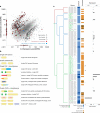Genome of the human hookworm Necator americanus
- PMID: 24441737
- PMCID: PMC3978129
- DOI: 10.1038/ng.2875
Genome of the human hookworm Necator americanus
Abstract
The hookworm Necator americanus is the predominant soil-transmitted human parasite. Adult worms feed on blood in the small intestine, causing iron-deficiency anemia, malnutrition, growth and development stunting in children, and severe morbidity and mortality during pregnancy in women. We report sequencing and assembly of the N. americanus genome (244 Mb, 19,151 genes). Characterization of this first hookworm genome sequence identified genes orchestrating the hookworm's invasion of the human host, genes involved in blood feeding and development, and genes encoding proteins that represent new potential drug targets against hookworms. N. americanus has undergone a considerable and unique expansion of immunomodulator proteins, some of which we highlight as potential treatments against inflammatory diseases. We also used a protein microarray to demonstrate a postgenomic application of the hookworm genome sequence. This genome provides an invaluable resource to boost ongoing efforts toward fundamental and applied postgenomic research, including the development of new methods to control hookworm and human immunological diseases.
Figures




Similar articles
-
Chromosome-Contiguous Ancylostoma duodenale Reference Genome from a Single Archived Specimen Elucidates Human Hookworm Biology and Host-Parasite Interactions.Int J Mol Sci. 2025 Jun 11;26(12):5576. doi: 10.3390/ijms26125576. Int J Mol Sci. 2025. PMID: 40565040 Free PMC article.
-
A hookworm allergen which strongly resembles calreticulin.Parasite Immunol. 1999 Sep;21(9):439-50. doi: 10.1046/j.1365-3024.1999.00238.x. Parasite Immunol. 1999. PMID: 10476053
-
Molecular cloning, biochemical characterization, and partial protective immunity of the heme-binding glutathione S-transferases from the human hookworm Necator americanus.Infect Immun. 2010 Apr;78(4):1552-63. doi: 10.1128/IAI.00848-09. Epub 2010 Feb 9. Infect Immun. 2010. PMID: 20145100 Free PMC article.
-
Improved insights into the transcriptomes of the human hookworm Necator americanus--fundamental and biotechnological implications.Biotechnol Adv. 2009 Mar-Apr;27(2):122-32. doi: 10.1016/j.biotechadv.2008.10.002. Epub 2008 Oct 18. Biotechnol Adv. 2009. PMID: 18977428 Review.
-
Hookworm vaccines.Clin Infect Dis. 2008 Jan 15;46(2):282-8. doi: 10.1086/524070. Clin Infect Dis. 2008. PMID: 18171264 Review.
Cited by
-
Modulating Composition and Metabolic Activity of the Gut Microbiota in IBD Patients.Int J Mol Sci. 2016 Apr 19;17(4):578. doi: 10.3390/ijms17040578. Int J Mol Sci. 2016. PMID: 27104515 Free PMC article. Review.
-
Identification of genetic variations in Necator americanus through resequencing by whole genome amplification.J Int Med Res. 2019 Sep;47(9):4353-4364. doi: 10.1177/0300060519862069. Epub 2019 Jul 23. J Int Med Res. 2019. PMID: 31331217 Free PMC article.
-
Stage-specific transcriptome of Bursaphelenchus xylophilus reveals temporal regulation of effector genes and roles of the dauer-like stages in the lifecycle.Sci Rep. 2019 Apr 15;9(1):6080. doi: 10.1038/s41598-019-42570-7. Sci Rep. 2019. PMID: 30988401 Free PMC article.
-
Improved PCR-Based Detection of Soil Transmitted Helminth Infections Using a Next-Generation Sequencing Approach to Assay Design.PLoS Negl Trop Dis. 2016 Mar 30;10(3):e0004578. doi: 10.1371/journal.pntd.0004578. eCollection 2016 Mar. PLoS Negl Trop Dis. 2016. PMID: 27027771 Free PMC article.
-
Soil-Transmitted Helminth Vaccines: Are We Getting Closer?Front Immunol. 2020 Sep 30;11:576748. doi: 10.3389/fimmu.2020.576748. eCollection 2020. Front Immunol. 2020. PMID: 33133094 Free PMC article. Review.
References
-
- Bethony J, et al. Soil-transmitted helminth infections: ascariasis, trichuriasis, and hookworm. Lancet. 2006;367:1521–32. - PubMed
-
- Hotez PJ, Bethony JM, Diemert DJ, Pearson M, Loukas A. Developing vaccines to combat hookworm infection and intestinal schistosomiasis. Nature reviews. Microbiology. 2010;8:814–26. - PubMed
-
- Loukas A, et al. Vaccinomics for the major blood feeding helminths of humans. Omics : a journal of integrative biology. 2011;15:567–77. - PubMed
-
- Diemert DJ, Bethony JM, Hotez PJ. Hookworm vaccines. Clinical infectious diseases : an official publication of the Infectious Diseases Society of America. 2008;46:282–8. - PubMed
Publication types
MeSH terms
Associated data
Grants and funding
LinkOut - more resources
Full Text Sources
Other Literature Sources
Molecular Biology Databases
Miscellaneous

